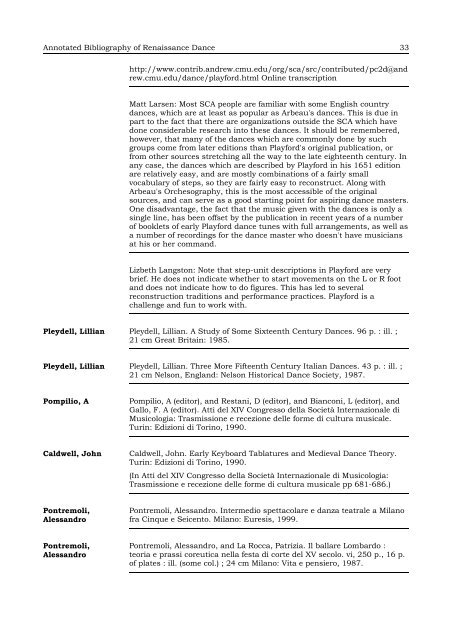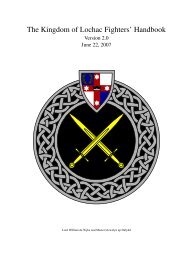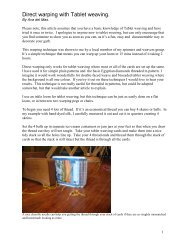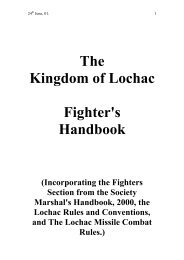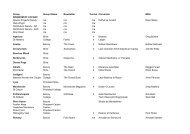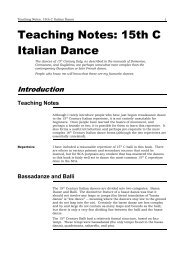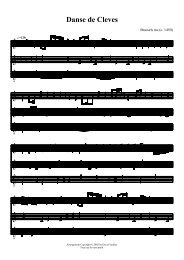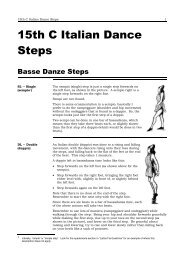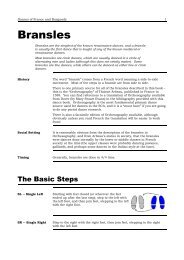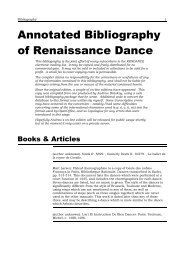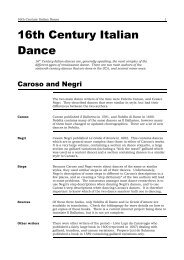Annotated Bibliography of Renaissance Dance - Shadow Island ...
Annotated Bibliography of Renaissance Dance - Shadow Island ...
Annotated Bibliography of Renaissance Dance - Shadow Island ...
- No tags were found...
Create successful ePaper yourself
Turn your PDF publications into a flip-book with our unique Google optimized e-Paper software.
<strong>Annotated</strong> <strong>Bibliography</strong> <strong>of</strong> <strong>Renaissance</strong> <strong>Dance</strong> 33http://www.contrib.andrew.cmu.edu/org/sca/src/contributed/pc2d@andrew.cmu.edu/dance/playford.html Online transcriptionMatt Larsen: Most SCA people are familiar with some English countrydances, which are at least as popular as Arbeau's dances. This is due inpart to the fact that there are organizations outside the SCA which havedone considerable research into these dances. It should be remembered,however, that many <strong>of</strong> the dances which are commonly done by suchgroups come from later editions than Playford's original publication, orfrom other sources stretching all the way to the late eighteenth century. Inany case, the dances which are described by Playford in his 1651 editionare relatively easy, and are mostly combinations <strong>of</strong> a fairly smallvocabulary <strong>of</strong> steps, so they are fairly easy to reconstruct. Along withArbeau's Orchesography, this is the most accessible <strong>of</strong> the originalsources, and can serve as a good starting point for aspiring dance masters.One disadvantage, the fact that the music given with the dances is only asingle line, has been <strong>of</strong>fset by the publication in recent years <strong>of</strong> a number<strong>of</strong> booklets <strong>of</strong> early Playford dance tunes with full arrangements, as well asa number <strong>of</strong> recordings for the dance master who doesn't have musiciansat his or her command.Lizbeth Langston: Note that step-unit descriptions in Playford are verybrief. He does not indicate whether to start movements on the L or R footand does not indicate how to do figures. This has led to severalreconstruction traditions and performance practices. Playford is achallenge and fun to work with.Pleydell, Lillian Pleydell, Lillian. A Study <strong>of</strong> Some Sixteenth Century <strong>Dance</strong>s. 96 p. : ill. ;21 cm Great Britain: 1985.Pleydell, Lillian Pleydell, Lillian. Three More Fifteenth Century Italian <strong>Dance</strong>s. 43 p. : ill. ;21 cm Nelson, England: Nelson Historical <strong>Dance</strong> Society, 1987.Pompilio, APompilio, A (editor), and Restani, D (editor), and Bianconi, L (editor), andGallo, F. A (editor). Atti del XIV Congresso della Società Internazionale diMusicologia: Trasmissione e recezione delle forme di cultura musicale.Turin: Edizioni di Torino, 1990.Caldwell, JohnCaldwell, John. Early Keyboard Tablatures and Medieval <strong>Dance</strong> Theory.Turin: Edizioni di Torino, 1990.(In Atti del XIV Congresso della Società Internazionale di Musicologia:Trasmissione e recezione delle forme di cultura musicale pp 681-686.)Pontremoli,AlessandroPontremoli, Alessandro. Intermedio spettacolare e danza teatrale a Milan<strong>of</strong>ra Cinque e Seicento. Milano: Euresis, 1999.Pontremoli,AlessandroPontremoli, Alessandro, and La Rocca, Patrizia. Il ballare Lombardo :teoria e prassi coreutica nella festa di corte del XV secolo. vi, 250 p., 16 p.<strong>of</strong> plates : ill. (some col.) ; 24 cm Milano: Vita e pensiero, 1987.


